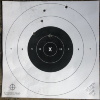Michael Tinker Pearce
Member
- Joined
- Oct 23, 2016
- Messages
- 1,574
Picked up a nice Astra Model 600. From appearances and the lack of markings it was a civilian-sale gun. It has no military or police markings, no foreign proofs and not even importer's markings. At 39 ounces unloaded it's no lightweight, but then you wouldn't want a straight blowback 9mm to be. It's a very nicely made gun with some interesting features, like the mag release button on the bottom of the left-side grip. It's in pretty good shape for a gun made in 1945. The trigger is neither particularly good or tragically bad; acceptable for a service pistol of it's vintage.


Recoil is odd; sort of soft-but-snappy. Not at all unpleasant, just different from locked-breech guns. Fired about a hundred rounds of mixed 124gr and 115gr Xtreme Bullets CPHPs and it functioned flawlessly. Sights are decent for a WW2 service gun, but not great. I'd have happily put another hundred rounds through it, but I had other guns to test. One thing the gun does not do naturally, and that's double-taps. The second shot always comes in low. I attribute this to the heavy slide slamming home and forcing the muzzle down. The grip angle isn't intuitive, but I had no trouble working with it.
First magazine- not bad, but a couple flyers because it's me. Seven yards, 1 shot per second:

Second magazine at fifteen yards, one shot per second:

Third target, five shots at 25 yards, no timer:

I did some more shooting at various ranges, and finished with this rapid-fire target at seven yards:

I have to say, for a WW2 service pistol this thing is weird but good. If I had to defend myself with it I would do so with confidence. I like it quite a bit, and will shoot it for fun. Very glad I picked it up!


Recoil is odd; sort of soft-but-snappy. Not at all unpleasant, just different from locked-breech guns. Fired about a hundred rounds of mixed 124gr and 115gr Xtreme Bullets CPHPs and it functioned flawlessly. Sights are decent for a WW2 service gun, but not great. I'd have happily put another hundred rounds through it, but I had other guns to test. One thing the gun does not do naturally, and that's double-taps. The second shot always comes in low. I attribute this to the heavy slide slamming home and forcing the muzzle down. The grip angle isn't intuitive, but I had no trouble working with it.
First magazine- not bad, but a couple flyers because it's me. Seven yards, 1 shot per second:

Second magazine at fifteen yards, one shot per second:

Third target, five shots at 25 yards, no timer:

I did some more shooting at various ranges, and finished with this rapid-fire target at seven yards:

I have to say, for a WW2 service pistol this thing is weird but good. If I had to defend myself with it I would do so with confidence. I like it quite a bit, and will shoot it for fun. Very glad I picked it up!





![IMG_3891[1].JPG](/data/attachments/932/932925-b6b1bc8110d202db903994ec1b8e4f59.jpg)
![IMG_7051[1].JPG](/data/attachments/932/932928-ffb4792559b8f8f7caa9bc4749340caf.jpg)
![IMG_7052[1].JPG](/data/attachments/932/932930-780b56efa8b5fff380eaf6661a93af99.jpg)
![IMG_3707[1].JPG](/data/attachments/932/932933-1a46629e01932a263b7cd2fe074fd9dc.jpg)
![IMG_3713[1].JPG](/data/attachments/932/932935-ad4457270ceb8746da752df2cd088add.jpg)

